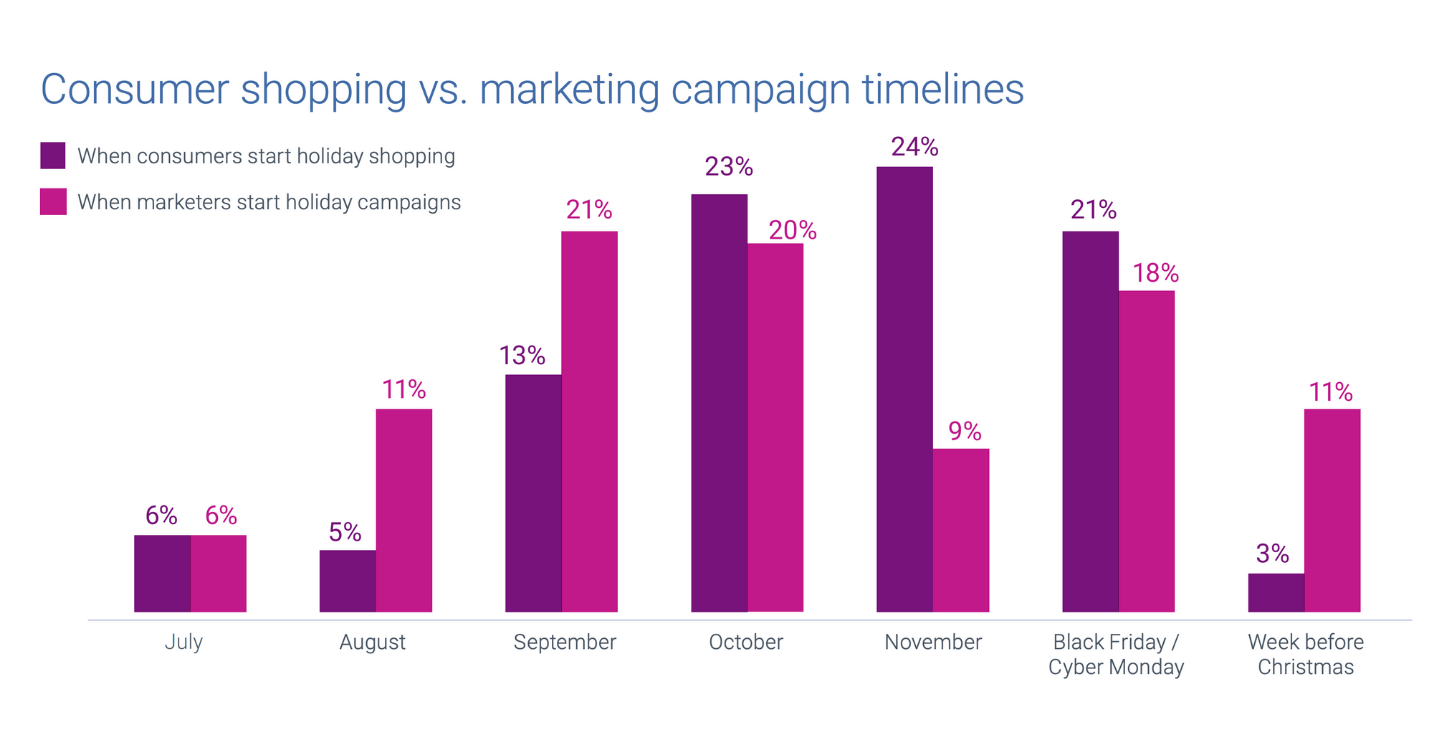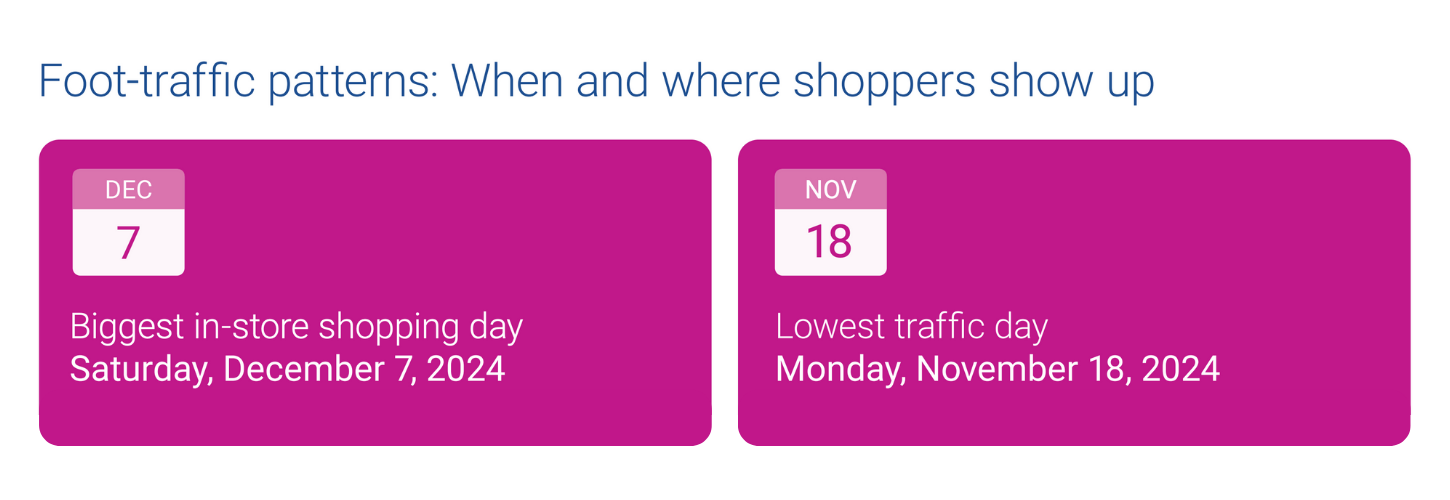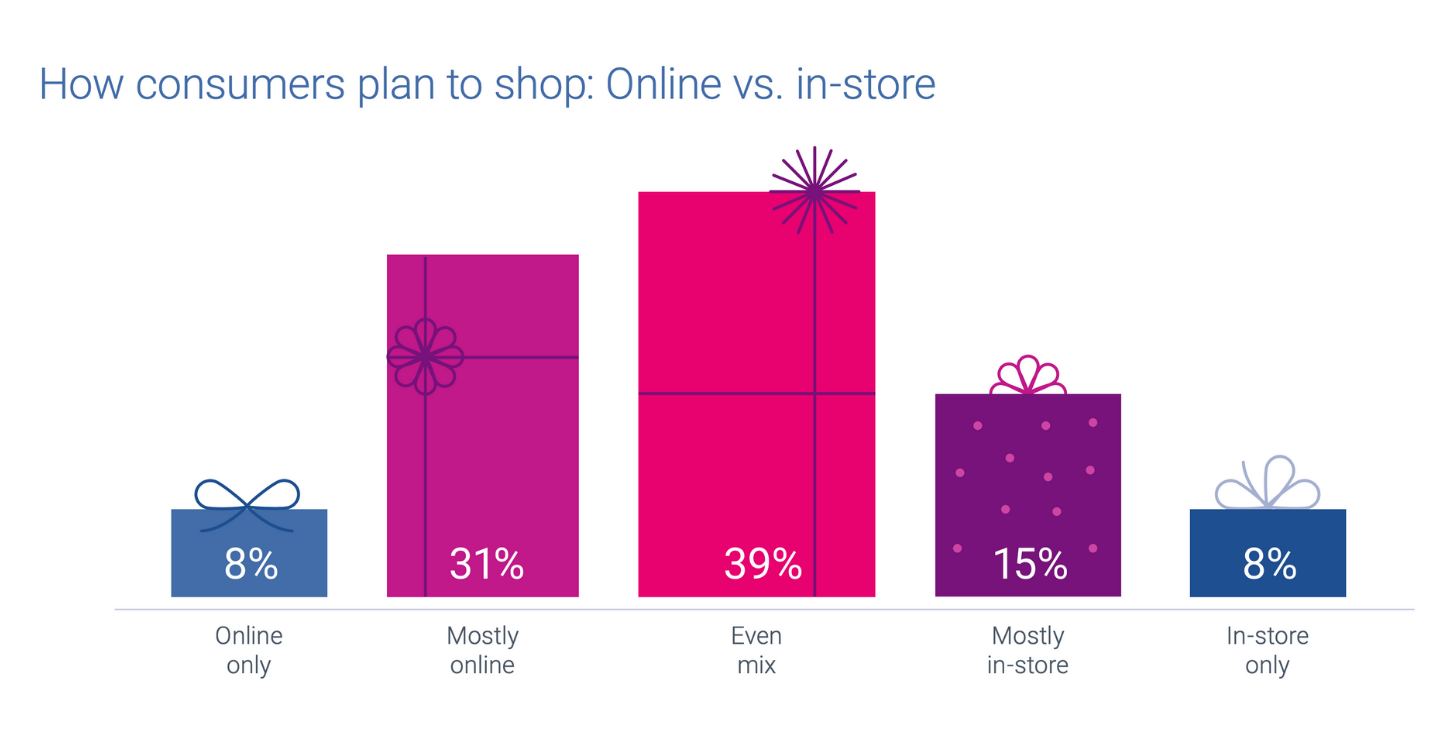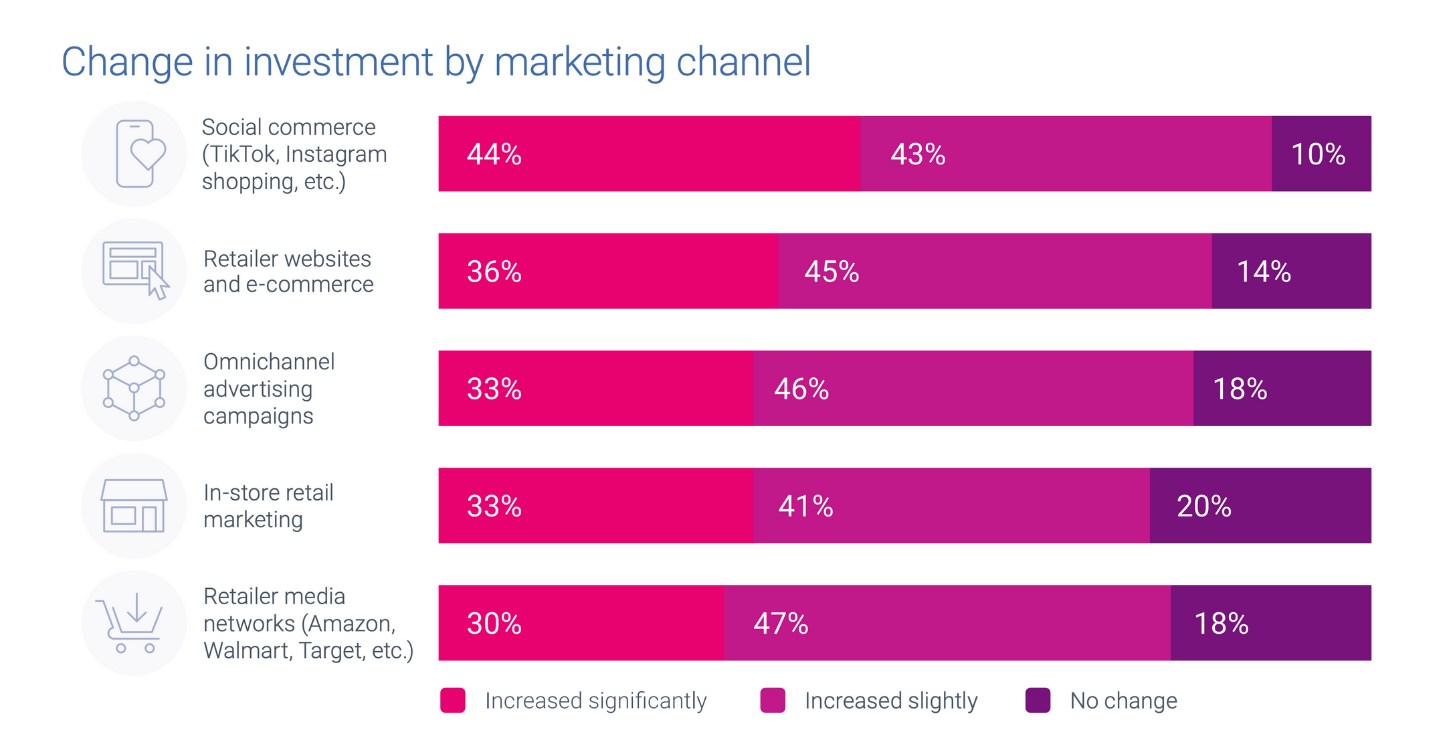At A Glance
Holiday shopping in 2025 doesn’t follow one clear pattern, with shoppers blending early planning and last-minute purchases, digital discovery and in-store validation, and cautious spending. Marketers who embrace this complexity, by staying relevant, consistent, and connected across channels, will be best positioned to win this season.Holiday shopping in 2025 feels a lot like a complicated relationship. Shoppers want deals, but they also want trust. They start shopping early, but they’re still browsing well into December. They love the convenience of online shopping, but they still show up in-store before making the final call.
Our 2025 Holiday spending trends and insights report, created this year in collaboration with GroundTruth, explores these contradictions. Our findings show that this year’s holiday season isn’t about one big shift; it’s about managing the push and pull between what consumers say, what they do, and how marketers respond.
Here are three complicated truths you need to know.
Experian’s 2025 Holiday spending trends and insights report
Optimize your 2025 holiday shopping campaigns with our latest report with GroundTruth.
Download now1. The new rules of holiday timing
Almost half (45%) of consumers plan to start shopping before November, but 62% admit they’ll still be buying in December. And post-holiday shopping (think gift card redemptions and deal-hunting) remains a real factor.


Why it’s complicated
The holiday calendar isn’t what it used to be. There’s no single “big moment” anymore. Instead, shoppers are spreading purchases across months, peaking around the “Turkey 12” (the 12 days surrounding Thanksgiving) and again in the final December rush.
What to do about it
- Stretch your campaigns across the full season, not just Cyber Week.
- Refresh offers to stay relevant as shopper motivations change from deal-seeking to last-minute urgency.
- Watch for post-holiday momentum and extend your promotions into January.
How belVita nailed the timing
In celebration of National Coffee Day, belVita partnered with GroundTruth on a one-month campaign to boost product awareness and drive foot traffic to Target stores. By utilizing digital out-of-home (DOOH) and mobile ads powered by location, behavioral, and purchase-based targeting, the campaign achieved a 3.44% visitation rate, nearly $476k in products added to carts, and a low cost-per-visit of just $0.22.
2. Online leads, but in-store still seals the deal
Nearly 40% of shoppers say they’ll split their purchases between online and in-store and 80% of consumers still prefer the in-store experience. Only a small fraction plan to shop exclusively in one channel. That means while digital often starts the journey, the final decision often happens in a physical store.

Why it’s complicated
Shoppers love the convenience of browsing online, but they still want the reassurance of seeing, touching, or testing products before buying. In-store isn’t just about the transaction, it’s the validation step.
What to do about it
- Build omnichannel strategies that connect digital discovery with in-store follow-through.
- Use location and identity data to tie digital impressions to real-world actions, like foot traffic and purchases.
- Focus on consistency: shoppers expect the same value, tone, and trust whether they’re on a website, in an app, or standing in a store aisle.
How Duke Cannon used on-premise targeting to drive sales lift
Duke Cannon, a premium men’s grooming brand, partnered with GroundTruth to launch a successful multichannel campaign utilizing location-based and behavioral audience targeting across CTV and mobile screens to drive in-store visits and sales.
By targeting consumers with mobile ads while they were physically in-store, the company capitalized on high purchase intent, aiding in the 12% sales lift. This strategic approach resulted in over 43.9k provable in-store visits and a significant increase in sales.
3. Marketers double down, consumers hold back
This holiday season, expectations are split. 66% of marketers expect holiday spend to rise, but only 22% of consumers agree. While brands are leaning into bigger investments across CTV, retail media, and social, shoppers are staying cautious, weighing value and waiting for the right deal.

Why it’s complicated
That disconnect introduces risk. If marketers don’t align spend with real consumer behavior, budgets can get wasted in the rush to cover every channel. Shoppers haven’t stopped spending, but they’re spending differently. They’re trading down to discount and big-box retailers while cutting back in discretionary categories like apparel and restaurants.
What to do about it
- Prioritize efficiency by focusing on the right audiences, not just more impressions.
- Make consistency your advantage: reach people once and connect across platforms instead of chasing fragmented signals.
- Balance aggressive media investment with messaging that acknowledges consumer caution — shoppers want value and trust, not hype.
Measuring TV and streaming impact with iSpot
iSpot’s Audience Builder, powered by Experian’s Marketing Attributes, helps brands reach high-value audiences. During the holiday season, a luxury retailer could target $100K+ households with affluent lifestyle interests. With iSpot’s Unified Measurement platform, they can track performance across linear TV and streaming and shift spend in real time to maximize results.
The bottom line on 2025 holiday shopping trends
This year’s holiday shopping season is, well…complicated. Shoppers are cautious but still engaged. They’re early planners and last-minute browsers. They want the ease of digital, but the confidence of in-person.
For marketers, the opportunity lies in embracing that complexity, not trying to simplify it away. The brands that balance relevance, trust, and convenience across the full season and across every channel will be the ones that win.
Download our full 2025 Holiday spending trends and insights report to explore all five shifts shaping this season and see how you can turn complexity into opportunity.
About the author

Fred Cheung
Director, Partnership Sales, Audigent, a part of Experian
Fred Cheung has spent over a decade in the programmatic advertising space, with roles at Mindshare, Jounce Media, Twitter, and The Trade Desk. His deep experience in trading and product management helps in his current function on the Experian Marketing Services’ Sales team where he focuses on data growth and adoption across the industries’ leading buy-side platforms.
2025 holiday shopping trends FAQs
Because consumer behavior is full of contradictions. People will shop earlier but also later, browse online but purchase in-store, and want deals while demanding trust. Marketers need to navigate these push-and-pull dynamics.
Nearly half (45%) say they’ll start before November, but 62% admit they’ll still be buying in December, with momentum even continuing into January through gift card redemptions and deal-hunting.
Although many consumers begin online, the majority still make their final decisions in-store. In-person shopping acts as a validation step where customers can see, touch, or try products before buying.
Instead of focusing only on Black Friday or Cyber Week, marketers should stretch campaigns across the full season, refresh offers frequently, and continue promotions into January.
Not entirely. 66% of marketers expect spending to rise, but only 22% of consumers agree. Shoppers are cautious, prioritizing value and often trading down to discount or big-box retailers.
An omnichannel approach using identity and location data can bridge digital impressions with real-world actions like store visits and purchases, ensuring consistency across touchpoints.
Brands like belVita and Duke Cannon successfully tied digital campaigns to in-store results by utilizing precise audience targeting, location data, and well-timed promotions.
You can download Experian’s 2025 Holiday spending trends and insights report to explore all five shifts shaping this season.
Latest posts

Originally appeared on MarTech Series Marketing’s understanding of identity has evolved rapidly over the past decade, much like the shifting media landscape itself. From the early days of basic direct mail targeting to today's complex omnichannel environment, identity has become both more powerful and more fragmented. Each era has brought new tools, challenges, and opportunities, shaping how brands interact with their customers. We’ve moved from traditional media like mail, newspapers, and linear/network TV, to cable TV, the internet, mobile devices, and apps. Now, multiple streaming platforms dominate, creating a far more complex media landscape. As a result, understanding the customer journey and reaching consumers across these various touchpoints has become increasingly difficult. Managing frequency and ensuring effective communication across channels is now more challenging than ever. This development has led to a fragmented view of the consumer, making it harder for marketers to ensure that they are reaching the right audience at the right time while also avoiding oversaturation. Marketers must now navigate a fragmented customer journey across multiple channels, each with its own identity signals, to stitch together a cohesive view of the customer. Let’s break down this evolution, era by era, to understand how identity has progressed—and where it’s headed. 2010-2015: The rise of digital identity – Cookies and MAIDs Between 2010 and 2015, the digital era fundamentally changed how marketers approached identity. Mobile usage surged during this time, and programmatic advertising emerged as the dominant method for reaching consumers across the internet. The introduction of cookies and mobile advertising IDs (MAIDs) became the foundation for tracking users across the web and mobile apps. With these identifiers, marketers gained new capabilities to deliver targeted, personalized messages and drive efficiency through programmatic advertising. This era gave birth to powerful tools for targeting. Marketers could now follow users’ digital footprints, regardless of whether they were browsing on desktop or mobile. This leap in precision allowed brands to optimize spend and performance at scale, but it came with its limitations. Identity was still tied to specific browsers or devices, leaving gaps when users switched platforms. The fragmentation across different devices and the reliance on cookies and MAIDs meant that a seamless, unified view of the customer was still out of reach. 2015-2020: The age of walled gardens From 2015 to 2020, the identity landscape grew more complex with the rise of walled gardens. Platforms like Facebook, Google, and Amazon created closed ecosystems of first-party data, offering rich, self-declared insights about consumers. These platforms built massive advertising businesses on the strength of their user data, giving marketers unprecedented targeting precision within their environments. However, the rise of walled gardens also marked the start of new challenges. While these platforms provided detailed identity solutions within their walls, they didn’t communicate with one another. Marketers could target users with pinpoint accuracy inside Facebook or Google, but they couldn’t connect those identities across different ecosystems. This siloed approach to identity left marketers with an incomplete picture of the customer journey, and brands struggled to piece together a cohesive understanding of their audience across platforms. The promise of detailed targeting was tempered by the fragmentation of the landscape. Marketers were dealing with disparate identity solutions, making it difficult to track users as they moved between these closed environments and the open web. 2020-2025: The multi-ID landscape – CTV, retail media, signal loss, and privacy By 2020, the identity landscape had splintered further, with the rise of connected TV (CTV) and retail media adding even more complexity to the mix. Consumers now engaged with brands across an increasing number of channels—CTV, mobile, desktop, and even in-store—and each of these channels had its own identifiers and systems for tracking. Simultaneously, privacy regulations are tightening the rules around data collection and usage. This, coupled with the planned deprecation of third-party cookies and MAIDs has thrown marketers into a state of flux. The tools they had relied on for years were disappearing, and new solutions had yet to fully emerge. The multi-ID landscape was born, where brands had to navigate multiple identity systems across different platforms, devices, and environments. Retail media networks became another significant player in the identity game. As large retailers like Amazon and Walmart built their own advertising ecosystems, they added yet another layer of first-party data to the mix. While these platforms offer robust insights into consumer behavior, they also operate within their own walled gardens, further fragmenting the identity landscape. With cookies and MAIDs being phased out, the industry began to experiment with alternatives like first-party data, contextual targeting, and new universal identity solutions. The challenge and opportunity for marketers lies in unifying these fragmented identity signals to create a consistent and actionable view of the customer. 2025: The omnichannel imperative Looking ahead to 2025 and beyond, the identity landscape will continue to evolve, but the focus remains the same: activating and measuring across an increasingly fragmented and complex media environment. Consumers now expect seamless, personalized experiences across every channel—from CTV to digital to mobile—and marketers need to keep up. The future of identity lies in interoperability, scale, and availability. Marketers need solutions that can connect the dots across different platforms and devices, allowing them to follow their customers through every stage of the journey. Identity must be actionable in real-time, allowing for personalization and relevance across every touchpoint, so that media can be measurable and attributable. Brands that succeed in 2025 and beyond will be those that invest in scalable, omnichannel identity solutions. They’ll need to embrace privacy-friendly approaches like first-party data, while also ensuring their systems can adapt to an ever-changing landscape. Adapting to the future of identity The evolution of identity has been marked by increasing complexity, but also by growing opportunity. As marketers adapt to a world without third-party cookies and MAIDs, the need for unified identity solutions has never been more urgent. Brands that can navigate the multi-ID landscape will unlock new levels of efficiency and personalization, while those that fail to adapt risk falling behind. The path forward is clear: invest in identity solutions that bridge the gaps between devices, platforms, and channels, providing a full view of the customer. The future of marketing belongs to those who can manage identity in a fragmented world—and those who can’t will struggle to stay relevant. Explore our identity solutions Contact us Latest posts

Consumers engage with content and advertisements across various devices and platforms, making an identity framework essential for establishing effective connections. An identity framework allows businesses to identify consumers across multiple touchpoints, including the relationships among households, individuals, and their devices. Combined with a robust data framework, businesses can understand the relationship between households, individuals, and marketing attributes. Consequently, businesses can tailor and deliver personalized experiences based on individual preferences, ensuring seamless consumer interactions across their devices. We spoke with industry leaders from Audigent, Choreograph, Goodway Group, MiQ, Snowflake, and others to gather insights on how innovations in data and identity are creating stronger consumer connections. Here are five key considerations for advertisers. 1. Embrace a multi-ID strategy Relying on a single identity solution limits reach and adaptability. Recent data shows that both marketers and agencies are adopting multiple identity solutions. By embracing a multi-ID strategy with solutions like Unified I.D. 2.0 (UID2) and ID5, brands can build a resilient audience targeting and measurement foundation, ensuring campaigns remain effective as identity options evolve across channels. A diversified identity approach ensures that advertisers are not left vulnerable to shifts in technology or policy. By utilizing multiple ID solutions, brands can maintain consistent reach and engagement across various platforms and devices, maximizing their campaign effectiveness. "I don't think it will ever be about finding that one winner…it's going to be about finding the strengths and weaknesses and what solutions drive the best results for us."Stephani Estes, GroupM 2. Utilize AI and machine learning to enhance identity graphs Identity graphs help marketers understand the connections between households, individuals, their identifiers, and devices. This understanding of customer identity ensures accurate targeting and measurement over time. AI and machine learning have become essential in making accurate inferences from less precise signals. These technologies strengthen the accuracy of probabilistic matches, allowing brands to understand consumer behavior more effectively even when data fidelity is lower. Adopting a signal-agnostic approach and utilizing various ID providers enhances the ability to view consumers' movements across platforms. This strategy moves measurement beyond isolated channels, providing a holistic understanding of campaign effectiveness and how different formats contribute to overall performance. By integrating AI and machine learning into identity graphs, advertisers can develop more cohesive and effective marketing strategies that guide customers seamlessly through their buying journey. "What we're finding is more and more identity providers are using Gen AI to locate connections of devices to an individual or household that maybe an identity graph would not identify."David Wells, Snowflake 3. Balance privacy with precision using AI AI-driven probabilistic targeting and identity mapping provide effective solutions for privacy-focused advertising. Rather than relying on extensive personal data like cookies, AI can use limited, non-specific information to predict audience preferences accurately. This approach allows advertisers to reach their target audience while respecting privacy—a crucial balance as the industry shifts away from traditional tracking methods. According to eMarketer, generative AI can further enhance audience segmentation through clustering algorithms and natural language processing. These tools enable more granular, privacy-compliant targeting, offering advertisers a pathway to reach audiences effectively without needing third-party cookies. "I think the biggest opportunity for machine learning and AI is increasing the strength and accuracy of probabilistic matches. This allows us to preserve privacy by building models based on the features and patterns of the consumers we do know, instead of transmitting data across the ecosystem."Brian DeCicco, Choreograph 4. Activate real-time data for better engagement Real-time data enrichment introduces dynamic audience insights into the bidding process, enabling advertisers to respond instantly to user actions and preferences. This agility empowers marketers to craft more relevant and impactful moments within each campaign. "Real-time data enrichment–where data companies can have a real-time conversation with the bid stream–is an exciting part of the future, and I believe it will open the door to activating a wide variety of data sets."Drew Stein, Audigent 5. Create and deploy dynamic personas using AI Generative AI transforms persona-building by providing advertisers with richer audience profiles for more precise targeting. This approach moves beyond traditional demographic categories, allowing for messaging that connects more meaningfully with each consumer. By using generative AI to craft detailed personas, advertisers can move beyond generic messaging to create content that truly resonates on an individual level. This personalized approach captures attention and strengthens consumer relationships by addressing their specific needs and interests. "One cool thing we've built recently is a Gen AI-based personas product that generates personas to create highly sophisticated targeting tactics for campaigns."Georgiana Haig, MiQ Seize the future of data-driven engagement Focusing on these five key innovations in data and identity allows you to adapt to the evolving media landscape and deliver personalized experiences to your audience. Contact us Latest posts

Originally appeared on Total Retail Retail media networks (RMNs) continue to demonstrate how they can be a powerful monetization driver for retailers, creating a win-win-win for everyone involved. Retailers can monetize their valuable first-party data as well as their online and in-store inventory, while customers benefit from timely, relevant content that enhances their shopping experience. At the same time, advertisers can reach highly targeted audiences at critical moments near the point of purchase Achieving this type of success requires overcoming challenges around fragmented and incomplete first-party data, which can limit a retailer's ability to organize and use their data effectively. Additionally, many RMNs lack the analytical capacity to generate customer insights, build addressable audiences, and accurately measure success. To realize the full potential of their platforms, RMNs need partners that provide complementary data, strong identity solutions, and the expertise to transform insights into actionable strategies. This allows RMNs to drive winning outcomes for themselves, marketers, and their customers. Here are the five steps an RMN should consider when selecting the right partner. 1. Build an identity foundation First, the right partner needs to be able to organize and clean customer data. Given the millions of customer records and data points that a retailer has, RMNs need to make sure their data is highly usable. Whether it is a known customer record or an unknown customer with incomplete data, partners should fill in missing information and connect fragmented customer records to a single profile. For example, RMNs need to know that a purchase made in-store is by the same customer who bought online. The best partners will then organize those profiles into households since targeting (and purchasing) is often done at the household level. Without a strong identity foundation future steps of segmentation, insights, audience creation, and activation will not be successful. Experian identity Experian's identity solutions provide RMNs with a comprehensive and accurate view of their customers across both offline and digital environments. We clean an RMN's first-party data and organize their customer records into households since targeting is often done at the household level and purchases are made at the household level. Using Experian's Offline and Digital Graphs we work with the RMN to fill in the missing information they have on their customers (e.g. name, address, phone number or digital IDs like hashed emails, mobile ad IDs, CTV IDs, Universal IDs like UID2 or ID5 IDs). This ensures that the retailers' entire customer base can be reached – and measured – across devices and channels. 2. Segment your customers An RMN’s ability to segment its customer base and derive insights depends on the availability and usability of their data assets – not to mention some serious analytical chops. Some RMNs will split their customers into different product segments based on what’s relevant to an advertiser. For example, a home improvement retailer may segment customers by who is buying DIY supplies versus improvement services. Other RMNs may develop custom segments from their customer data and third-party data sources, so that advertisers can personalize their marketing based on life stage, age, income level, geography, and other factors. Either approach is effective but requires working with a partner who has high quality data and deep analytical expertise to develop those segments. Segment with Experian Experian Marketing Data helps an RMN learn about their customer beyond their first-party data. With access to 5,000 marketing attributes, RMNs can fill in the holes in their understanding of a customer. We provide them with demographic, geographic, finance, home purchase, interests and behaviors, lifestyle, auto data and more. RMNs can use this enriched data set to create addressable audience segments. 3. Generate actionable insights about these segments Once the RMN determines how they will segment their customers, they can utilize demographic, attitudinal, interest, and behavioral data from a trusted partner to develop a customer profile that compares its customers against a relevant sample of consumers. Here, the RMN will gain insight that will help them answer questions about its customers. Examples include: What age and income groups are more likely to purchase my product? What is the current life stage of my customers – do they have children, are they married, are they empty-nesters? Is price or quality more important to customers in their decision-making process? What sort of activities do my customers enjoy? How frequently do my customers shop for similar merchandise? What media channels do my customers use to get their information? Expanded insights with Experian With Experian’s advanced customer profiling, RMNs can go beyond basic customer segmentation. We build detailed customer profiles by utilizing accurate, attribute-rich consumer data, so RMNs can gain a more comprehensive understanding of their customer’s preferences, life stages, and purchasing behaviors. Having this insight enables the RMN to: Design a targeted email campaign promoting home essentials to recently married new homeowners. Develop a social media post announcing the opening of a new hardware store to users within a specific location interested in do-it-yourself products. Create brochures and flyers at a local community event tailored towards parents with small children that promote equipment for youth sports leagues. 4. Create high quality lookalike audiences The RMN now knows what distinguishes their customers from other consumers and can create audiences that enable advertisers to run personalized marketing campaigns at scale. RMNs can do this in several different ways: Work with a data provider who can create custom audiences for the RMN (e.g., Ages 40-49 and Leisure Travelers and past purchase of travel item) These custom audiences are created by joining multiple first- and third-party data attributes found to be significant in the customer profile or using machine learning techniques to develop a custom audience unique to the advertiser. Custom audiences with Experian With an enriched understanding of their customers, RMNs can create addressable custom audience segments, including lookalike audiences, for advertisers. 5. Expand addressability of audiences and activate on multiple destinations Once audiences are created, RMNs will want to increase a marketer’s reach across on-site and off-site channels. With the right identity graph partner, an RMN can add digital identifiers to customer records that enable activation across media channels, including programmatic display, connected television (CTV), or social. RMNs should work with identity providers that are not reliant on third-party cookies. They should select partners that offer more stable digital IDs in their graph like mobile ad IDs (MAIDs), hashed emails (HEMs), CTV IDs, and universal IDs like Unified I.D. 2.0 (UID2). Experian powers data-driven advertising through connectivity Using Experian's Digital Graph, RMNs expand the addressability of their audiences by assigning digital identifiers to customer records. Marketers will be able to reach an RMNs customers onsite as well as offsite since Experian provides several addressable IDs. Audiences can be activated across an RMNs owned and operated platform as well as extended programmatically to TV and the open web through Experian's integrations across the ecosystem. Maximize your RMN’s revenue potential with Experian Organizing customer data, segmenting customers, generating insights, creating addressable audiences, and activating campaigns are all critical steps for an RMN to realize that revenue potential. RMNs should select a partner that provides the data, identity, and analytical resources to create the winning formula for marketers, customers, and retailers. Experian’s data and identity solutions are designed to help RMNs maximize their revenue potential. Reach out to our team to discover how we can support your path to RMN success. Connect with us Latest posts